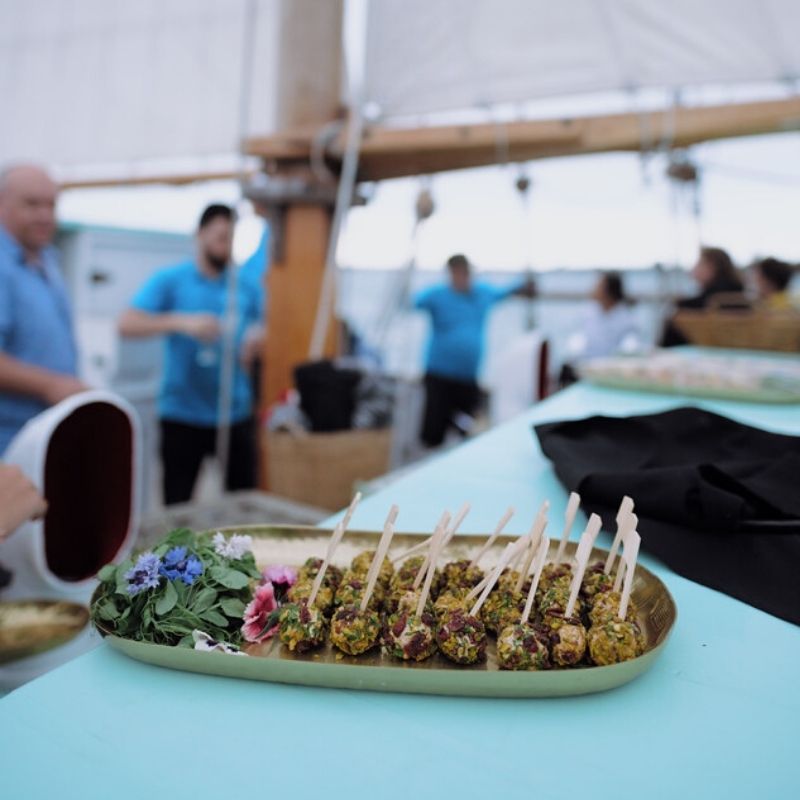TED ASHBY
Set sail on our heritage scow, Ted Ashby, for an hour-long cruise on Tāmaki Makaurau/Auckland's Harbour. See the city skyline, Sky Tower and Auckland Harbour Bridge from the sea.
Set sail on our heritage scow, Ted Ashby, for an hour-long cruise on Tāmaki Makaurau/Auckland's Harbour. See the city skyline, Sky Tower and Auckland Harbour Bridge from the sea.
Set sail with us today and explore the sparkling Waitematā.
Christmas parties, anniversaries, birthdays and events. Book a 90minute chartered sailing with drinks and canapés for up to 40 people.

Please advise of your access needs upon making your booking.
Wheelchairs are permitted on TED ASHBY, depending on the dimensions of the wheelchair.
People using a wheelchair must be able to wear a lifejacket and be accompanied by a caregiver.
Only a maximum of two wheelchairs can be accommodated per sailing on TED ASHBY.
Yes, we are a family friendly Museum and our sailings are a great way for children to experience the water.
All children 14 years and under shall wear a lifejacket which shall be provided by the New Zealand Maritime Museum.
Any child not wearing a lifejacket shall not be permitted on board the vessel.
Children must have suitable adult supervision on board the vessel. The following supervising adult to children ratio below must be followed (excluding schools):
- 1 adult to every child aged 5 or under
- 1 adult to every 5 children, school year 1-8
- 1 adult to every 10 children, school year 9-13
Prams are permitted onboard TED ASHBY.
Yes, Double and Family sailing passes are available to purchase at our Museum shop or over the phone on (09) 373 0800.
Our sailings are likely to go ahead in wet weather conditions. The Museum can offer water-proof rain jackets as needed.
Strong winds may cause cancellations.
If it proves necessary for the New Zealand Maritime Museum to make any changes or cancellations to dates and/or times of vessel sailings for weather, safety, maintenance and/or operational requirement, staff will endeavour to provide as much notice as is reasonably possible using the contact details provided in your booking, and where possible, your booking will be transferred to a similar sailing. If another suitable date is not available, a full refund will be provided.
Sailing passes for TED ASHBY also include admission into the Museum.
Life jackets and rain jackets are provided when necessary at no extra cost.
Visitors should check in at the museum's front desk 30 minutes before the scheduled sailing time. We aim to board passengers 15 minutes before departure.
Unfortunately, late arrivals may result in non-boarding of the vessel and payment may not be refunded.
Food and non-alcoholic beverages are permitted on board. You are welcome to bring your own snacks and water, or you can purchase something from our cafe before boarding.
Ted Ashby is a ketch-rigged deck scow, typical of the fleet of scows that once operated in northern New Zealand waters.
Built by Museum staff and volunteers in the traditional manner, she was launched in August 1993. Freightways Ltd sponsored her construction with assistance by many other firms.
Ted Ashby is built of blackbutt, an Australian hardwood grown in Northland, instead of the traditional kauri. She is fastened with galvanised steel bolts and spikes. The hull is framed with fore-and-aft bulkheads, known as partitions, and the bottom is cross-planked. Underwater the hull is sheathed in worm-resistant totara over tarred felt and schenam, a mixture of lime and oil.
Scows were flat-bottomed, centreboard vessels, most of which carried their cargo on deck. They were ideal for working estuaries and shallow harbours, and they carried logs, firewood, sand and shingle, machinery and stock. A few of the larger scows carried timber to Australia and America.
Scows ranged from 45 to 130 foot in length and most were two-masted, ketch or schooner rigged. The largest were three-masted. Some 130 scows were built in the north of New Zealand between 1873 and 1925. The first was the Lake Erie, based on the American Great Lakes scows. New Zealand scows quickly developed their own characteristic form and construction. Today only half a dozen survived.
The Maritime Museum chose to name the vessel after Ted Ashby, a man whose whole life was intimately involved with the scows, and the author of the book 'Phantom Fleet'.